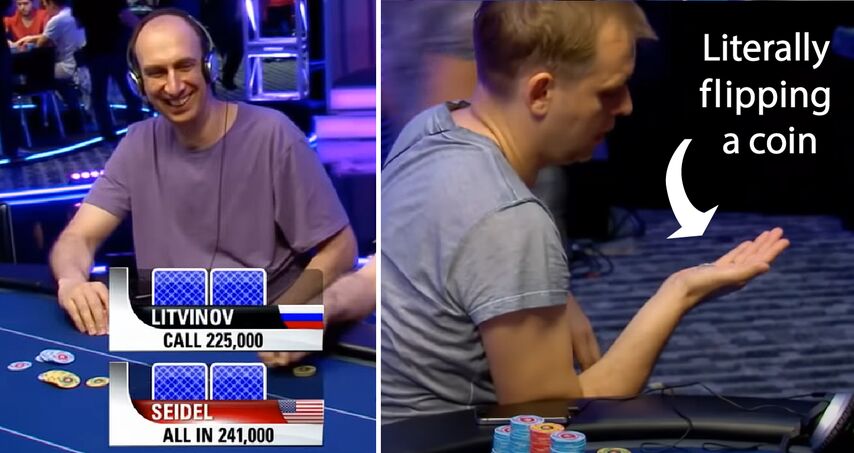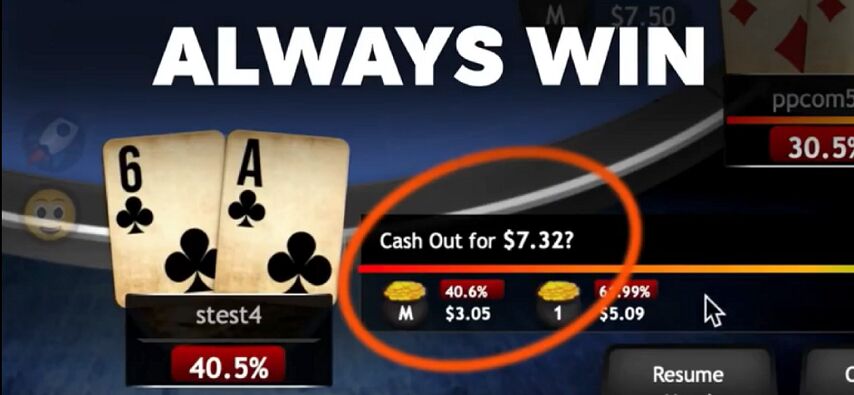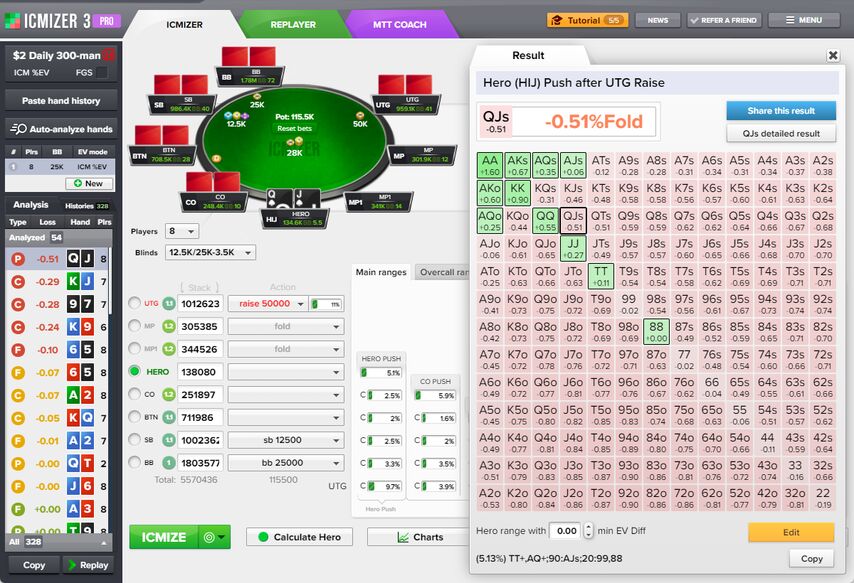What is a coinflip in poker?
If two hands of near-equal strength go head to head, that’s a coinflip in poker. When any player or poker commentator says something like, “It’s a coinflip!”, they are implying each player has 50% to win (or close to it).
There’s an important distinction to make though. A coinflip is not a situation where players are likely to draw or split the pot, for example, A♦ K♠ vs A♣ K♥. A more typical flip would be Q♠ Q♦ vs A♥ K♥ or J♠ 10♠ vs 6♦ 6♥. In most coinflips, the pot is expected to go to one player or the other.

You can always simulate hands through our Odds Calculator to see specific matchups.
Some players do flip coins to help them randomize their decisions, (like you can see in the picture below) but this article will only be covering coinflip matchups between specific hands.
If you came here to read about randomization, we recommend looking at our randomizer tool and reading the guide below it.

Common Coinflip Examples
Usually, coinflip is a poker term you’ll hear when players go all in during a tournament or cash game. 50/50 odds are far from ideal and no poker player is in love with the idea of staking their tournament life on a coinflip. Getting your money in with more equity than 50/50 is always better.
Here are some of the most common coin flips you will see in poker:
A-K vs a pocket pair

This happens quite often in poker. Two overcards threaten the pair, but the pair is ahead before the flop cards come. If the A♦ K♦ finds one of the 6 outs (A♠ A♥ A♣ + K♠ K♥ K♣) on the flop, the odds of the pocket pair winning can drastically drop (to around 10%).
Of course, premium pocket pairs like Q♠ Q♥, J♠ J♥, and even 10♠ 10♥ have increased odds (about 54%) against the A♦ and K♦ overcards.
Even 2♥ 2♣ is almost exactly 50/50 to win against A♦ K♦, which is a true coinflip.
A-10 vs K-Q

Even though the odds are clearly in favor of A♣ 10♣, this matchup is still considered a coinflip. The odds are still relatively close and the A♣ 10♣ only has a small advantage over K♦ Q♦.
Similar matchups might include A♣ 9♣ vs K♦ 10♦ (56.5% vs 43%) and even A♥ 5♥ vs J♠ 10♠ (54% vs 45%).
K-X vs a lower pocket pair

This matchup is essentially the same as A♦ K♦ vs 9♣ 9♥. The player with the pocket pair will get extra equity if their cards deny flush and straight outs from the opponent. K♦ J♦ vs 10♦ 10♣ is a better match-up for the pocket pair (46% vs 54%)
You’ll encounter these kinds of situations frequently if you play online poker because you see more hands than live poker.
If you want to test out different coinflips and check your odds, try our Free Odds Calculator.
Avoid Bad Beats Using Cashout Features
If you haven’t heard of “cashing out EV” or “EV cashouts”, here you go.
Someone at your partypoker cash game went all in and you fearlessly called with 10♦ 10♥. Your opponent shows A♣ K♣, which gives you a just under 54% chance of winning the hand.
You could accept those odds, or you could get paid 54% of the pot, minus 1%. Depending on the size of the pot and your odds, cashing out your EV and preserving your stack (while collecting a small profit) may make sense.

You don’t always want to use the feature though. Let’s say you have just gone all in and your opponent calls. You have a beautiful hand, Q♦ Q♣, but you’re surprised to see your opponent has 6♥ 7♥.
You have more than a 77% chance of winning the pot and that’s a great spot to be in. You probably shouldn’t use the All-in Cashout feature.
This feature applies to all-ins during cash games at partypoker, but not tournaments. The Cashout button will appear anytime it’s available to use.
Understand Poker Ranges to Understand Coinflips
Your opponents aren’t going to tell you their hand, so you need to be able to put them on a range. We’ve written short guides on poker ranges, but we’ll deliver a crash course here.
A range includes all of the hands we think our opponent could have at a specific moment. For coinflips, you’ll want to learn more about preflop opening ranges and preflop push/fold ranges.

We’ve got the perfect program for you. ICMIZER increases your knowledge about the push/fold all-in ranges, meaning you can perform better in the late stages of MTTs (multi-table tournaments).
The software can even test the hands you’ve played online and find your mistakes. If you had a hand that you thought you should have played differently, ICMIZER will let you view it in the Replayer, then test alternate actions.
Coinflip Strategy for Poker Tournaments
You always get a choice in poker. When it comes to coinflips, it’s best to decide which ones to take and which ones to get away from.
Most coinflips start when one player pushes all in and another decides to call.
Consider your tournament position and stack size.
Taking a coinflip could bring a lot of chips over to your stack, but are you risking too much? If you are in a comfortable position in the tournament and have a healthy stack, you want to be more selective about coinflips. It might be more practical to accept coinflips against smaller stacks.
But what about when you move all in?
If you push all in, you get something called “fold equity”. This differs from your normal equity, meaning your chance of winning the pot. When you are the one going all in, you give yourself a chance to win the pot when your opponent folds. That’s fold equity.
The player calling never has fold equity, of course, because you cannot fold after going all in.
Sometimes in poker tournaments, you reach a stage where you must start making these moves. You don’t want to always be the one initiating coinflips, but you don’t always want to be the caller either. When it makes sense, take advantage of your extra fold equity and put your opponent to a tough decision.
Start practicing right now, for free. We’ve got a long list of free poker tournaments going on, with real cash prizes to win.





















